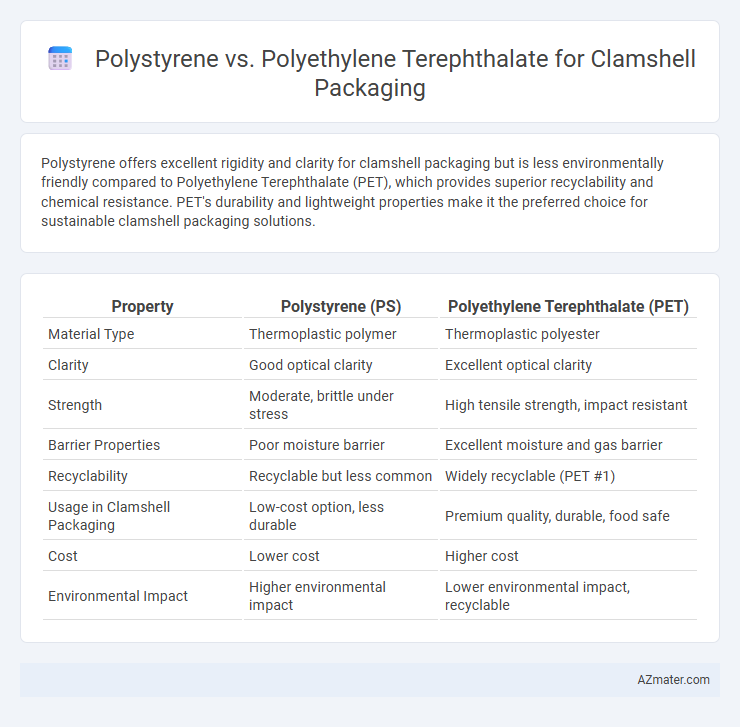Polystyrene offers excellent rigidity and clarity for clamshell packaging but is less environmentally friendly compared to Polyethylene Terephthalate (PET), which provides superior recyclability and chemical resistance. PET's durability and lightweight properties make it the preferred choice for sustainable clamshell packaging solutions.
Table of Comparison
| Property | Polystyrene (PS) | Polyethylene Terephthalate (PET) |
|---|---|---|
| Material Type | Thermoplastic polymer | Thermoplastic polyester |
| Clarity | Good optical clarity | Excellent optical clarity |
| Strength | Moderate, brittle under stress | High tensile strength, impact resistant |
| Barrier Properties | Poor moisture barrier | Excellent moisture and gas barrier |
| Recyclability | Recyclable but less common | Widely recyclable (PET #1) |
| Usage in Clamshell Packaging | Low-cost option, less durable | Premium quality, durable, food safe |
| Cost | Lower cost | Higher cost |
| Environmental Impact | Higher environmental impact | Lower environmental impact, recyclable |
Introduction to Clamshell Packaging Materials
Clamshell packaging commonly utilizes materials like polystyrene and polyethylene terephthalate (PET) due to their durability and clarity. Polystyrene offers excellent rigidity and cost-effectiveness, making it suitable for lightweight, protective packaging. PET provides superior chemical resistance, recyclability, and transparency, enhancing product visibility and sustainability in packaging applications.
Overview of Polystyrene (PS)
Polystyrene (PS) is a versatile thermoplastic polymer widely used in clamshell packaging due to its clarity, rigidity, and excellent insulating properties. It offers high impact resistance and superior printability, making it ideal for displaying fresh produce, bakery items, and deli products. Despite its benefits, PS has lower barrier properties compared to Polyethylene Terephthalate (PET), resulting in less effective moisture and oxygen resistance.
Overview of Polyethylene Terephthalate (PET)
Polyethylene Terephthalate (PET) is a thermoplastic polymer widely used for clamshell packaging due to its excellent clarity, strength, and chemical resistance. Its high tensile strength and impact resistance make PET suitable for protecting food and fragile items while maintaining visibility. PET is also recyclable and offers superior barrier properties against moisture and gases compared to Polystyrene, enhancing product shelf life.
Mechanical Strength: PS vs PET
Polystyrene (PS) offers rigid mechanical strength with high impact resistance, making it suitable for protective clamshell packaging that requires durability under stress. Polyethylene terephthalate (PET), however, provides superior tensile strength and flexibility, enhancing the package's ability to withstand deformation without cracking or breaking. PET's combination of stiffness and resilience often results in better performance for packaging applications demanding both durability and clarity.
Clarity and Transparency Comparison
Polystyrene offers superior clarity and transparency for clamshell packaging, providing a high-gloss finish that enhances product visibility. Polyethylene terephthalate (PET) also delivers excellent transparency but tends to have a slightly more muted gloss compared to polystyrene. The choice between the two materials depends on the desired visual appeal and marketing needs, with polystyrene favored for maximum clarity and PET selected for durability with good transparency.
Barrier Properties and Food Preservation
Polystyrene offers moderate barrier properties against oxygen and moisture, making it suitable for short-term food preservation but less effective than polyethylene terephthalate (PET), which provides superior resistance to oxygen permeability and moisture vapor transmission. PET's enhanced barrier characteristics extend shelf life by maintaining food freshness and preventing contamination, making it the preferred choice for clamshell packaging in fresh produce and deli items. The rigidity and clarity of PET also contribute to better product visibility and protection, supporting both food safety and consumer appeal.
Environmental Impact and Recyclability
Polystyrene (PS) clamshell packaging is lightweight but poses significant environmental challenges due to its low biodegradability and limited recyclability, often ending up in landfills or as ocean pollutants. Polyethylene terephthalate (PET) offers a more sustainable solution, as it is widely recyclable, boasts a higher recycling rate, and decomposes more effectively in controlled environments. PET's ability to be reprocessed into multiple high-quality products reduces environmental impact and promotes circular economy principles in packaging.
Cost Effectiveness and Market Availability
Polystyrene (PS) offers a lower production cost and high clarity, making it a cost-effective option for clamshell packaging in large volumes. Polyethylene Terephthalate (PET) provides superior strength, chemical resistance, and recyclability, which often results in higher upfront costs but better long-term value through enhanced durability and consumer appeal. Market availability favors PET due to its widespread use in food and beverage packaging, driven by increasing environmental regulations and demand for sustainable packaging solutions.
Safety and Regulatory Compliance
Polystyrene (PS) and Polyethylene Terephthalate (PET) differ significantly in safety and regulatory compliance for clamshell packaging, with PET generally recognized as safer due to its inert nature and lower risk of chemical leaching. PET complies with FDA regulations for food contact materials, offering strong resistance to moisture and gases, which reduces potential contamination and ensures shelf-life integrity. Polystyrene, while approved for food use, raises concerns about styrene migration and brittleness, demanding stricter testing and limitations under regulatory frameworks such as EU REACH and FDA guidelines.
Best Applications: Choosing Between PS and PET
Polystyrene (PS) clamshell packaging excels in providing rigid, transparent containers ideal for bakery goods, deli items, and fresh produce where visibility and lightweight protection are essential. Polyethylene Terephthalate (PET) offers superior strength, chemical resistance, and recyclability, making it the preferred choice for beverages, ready-to-eat meals, and perishable food items requiring extended shelf life and enhanced durability. Selecting between PS and PET depends on factors like product type, barrier properties, environmental impact, and cost efficiency in packaging applications.

Infographic: Polystyrene vs Polyethylene Terephthalate for Clamshell Packaging
 azmater.com
azmater.com